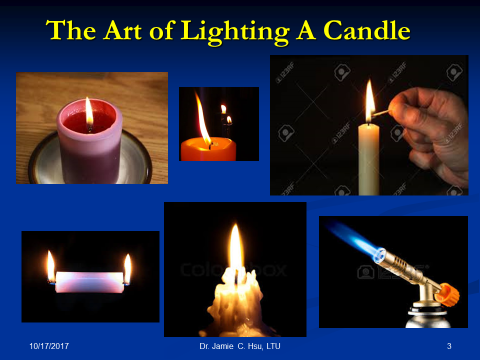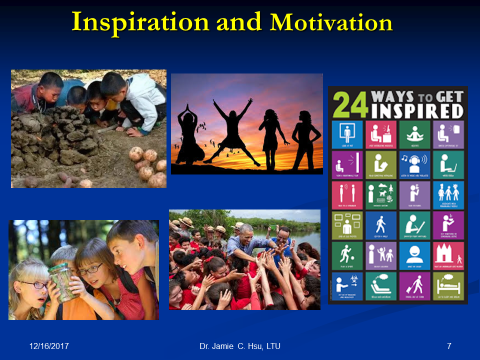
The Art of Lighting a Candle (motivating someone)
– Musings of Dr. Jamie C. Hsu, 12.31.2017
In discussions with friends about Blog 33: Lighting the Candles, it appeared to me that there is a lot more to lighting a candle and maintaining a nice flame, just like there is a lot to motivating and nurturing a young mind. It takes knowledge, empathy, understanding, and patience to motivate someone. It is a science and an art.
When lighting a candle, one needs first to find the wick, lift it up, and then light it with a gentle and controlled heat. After the flame can be sustained on its own with the candle wax, the heat source is removed. To ensure a nice and steady flame, the candle is put in an upright position and away from wind gusts. Otherwise the flame will either go out or burn wildly, and the candle will be consumed in a short time.
As depicted in the photos, a properly lit candle will maintain its flame and wax for a long period of time, while a poorly lit candle will melt by the excessive torch heat or burnout prematurely by the out-of-control flames.
The same can be said about our effort to motivate and inspire someone. We first need to understand the person’s internal drive (the wick), and then provide the proper coaching and incentives (the heat). With the initial success in piquing his interest to learn and improve (the flame), we must provide continued encouragement and critique (the environment) to sustain his desire for continuous improvements. By then, we will all be happy in the steady glow of this flame and success.
One quick example is my granddaughter’s piano lesson. After switching to a new teacher recently, her improvement and eager attitude in playing piano is phenomenal. Her fingering is better, she is happy playing, she is proud of her progress, and she views piano as her hobby, not just a must-do lesson. What a difference it makes when the wick is found, lit, and nurtured.
I hope you will learn and master the art of lighting candles and try to be the lighting rod to inspire and motivate those you care about and love.
Maybe you can start with yourself: where is your wick, and what will inspire and motivate you in the coming New Year?


點蠟燭 (激勵他人) 的藝術
–作者 許俊宸博士
–中譯 薛乃綺
跟朋友討論Blog 33:Lighting the Candles時,我覺得在點燃蠟燭跟保持火焰這件事上,還有很多可以聊的;就像要如何激勵和滋養一個年輕的心靈,是需要知識、同情、理解以及耐心才能做到的。那是一門科學與藝術並重的學問。
當點燃一支蠟燭時,首先需要找到燭芯,將它挑起,然後用溫和的火苗點燃蠟燭、並先保持控制好點火源。一旦所燃起的燭火可以自行維持繼續燃燒時,才將火源移開。為了確保燭火燒得好且穩定,必須將蠟燭放直、且要避開風口。否則,火焰會短時間內熄滅或者是很快就燃燒殆盡。
就像此文中所附的照片所示,蠟燭點得好,可以長時間保持燭火及蠟燭的形狀;而點不好的蠟燭,則會被過猛的燭火給融化、又或者被失控的火源給燒光了。
而我們想要激勵或啟發某人所做的努力,也是同個道理。不能只是用大火和不停的唠叨。我們要先了解他的內在動力(燭芯),然後提供適當的指導與激勵(火源)。當對他所激發的學習和提高興趣有初步成功時,我們必須要繼續鼓勵及指導(環境),以維持他想要不斷精進的意願。屆時,我們都會為這個火焰能成功穩定地發光發熱而感到高興。
有個現成的例子就是我孫女的鋼琴課。最近換了新老師後,她彈鋼琴的進步、還有熱切的態度就是個明顯的改變。她不但指法變好了、也彈得很開心,更為自己的進步感到自豪;她把鋼琴看成是自己的嗜好,而不僅是一個必須要上的課程。可見當燭芯被找到、點燃、培育時,它會帶來多大的改變。
希望你也能學習並掌握點蠟燭的藝術,還能成為照明棒,去激勵、啟發你關心愛護的人。
也許你可以從自己開始:你的燭芯在哪?在即將到來的新年裡,什麼能激勵、啟發你呢?


